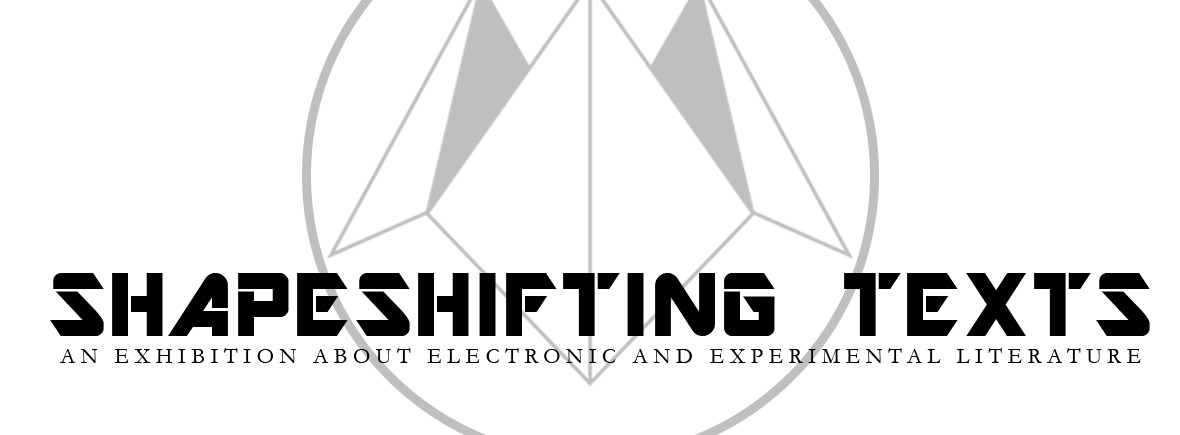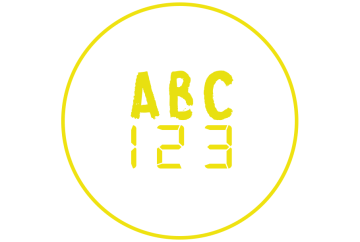Shapeshifting Texts
Electronic literature is an ever-changing field which makes clear the intersections between multiple art forms, semiotic languages and experiences with the medium. This literary form thrives on dialogues between digital art, cinema, performance, comics, or games. The exhibition “Shapeshifting texts” aimed to present a selection of works that incorporate these possibilities of interconnection. It was organized in collaboration with the ongoing project “Archiv der deutschsprachigen elektronischen Literatur” (Germany) and featured works included in several archives of electronic and experimental literature. The curatorial and archival work done by the Digital Archive of Portuguese Experimental Literature Po.ex.net (Portugal), ELMCIP (Norway), Electronic Literature Lab (USA), Electronic Literature Directory and Nt2 (Canada), I ♥ E-Poetry was displayed in this exhibition. Our aim was to present the collaborative work done by institutions and archives focused on the preservation of electronic and experimental literature and, simultaneously, to demonstrate that electronic literature is part of an ever-evolving process which might have been catalysed by the first experiences with language and surfaces of inscription. At Staats- und Universitätsbibliothek Bremen, from the 3rd to the 5th of November 2016, visitors have attended artist talks and read over than twenty works that shapeshift at different levels, often depending on assemblage and recalibration to be experienced. This exhibition was linked with the International Conference on Digital Media and Textuality, also organised by Daniela Côrtes Maduro, as part of the project “Shapeshifting Texts: keeping track of electronic literature“.
Besides the works here presented, visitors could also find the following books, owned by the Staats- und Universitätsbibliothek Bremen:
Das Passagen-Werk (1927-1940), Walter Benjamin
The Third Mind (1978), William Burroughs and Brion Gysin
Das Sandbuch (1975), Jorge Luis Borges
1001 nights (2005)
Alice in Wonderland (1946), Lewis Carroll
Caligrammes (1948), Guillaume Apollinaire
Les Mots Cróises (1999), Georges Perec
Jeux Intéressants (2003), George Perec
Alphabets (2001), George Perec
Frankenstein (1818), Mary Shelley
Die Märchen der Brüder Grimm (1985), Jacob Grimm
I Ching
Se una notte d’inverno un viaggiatore (1979), Italo Calvino
Exercices de Style (1947), Raymond Queneau
Die Leiden des jungen Werthers (1744), Johann Wolfgang von Goethe
Ficciones (1979), Jorge Luis Borges
Recombinant Surfaces
“After the novel, and subsequently cinema privileged narrative as the key form of cultural expression of the modern age, the computer age introduces its correlate – database.” Lev Manovich, in The Language of New Media (2001) Electronic literature can shapeshift randomly by resorting to a database of images, sounds or words. The following works were … Continue reading Recombinant Surfaces
Hybrid Surfaces
“When we have business with language, we are possessed by its dreams and demons, we grow intimate with monsters. We become hybrids, chimeras, centaurs ourselves: steaming flanks and solid redoubtable hoofs galloping under a vaporous machinery.” Shelley Jackson, in Patchwork Girl (1995) The works here presented can shapeshift between several semiotic modes and art forms. … Continue reading Hybrid Surfaces
Alphanumeric Surfaces
“A sense of fascination and adventure told me that the letters and the signs standing still on the page could gain actual movement of their own. The words and the letters could at last be free, creating their own space.” E. M. de Melo e Castro, in Media Poetry: An International Anthology (2007), Eduardo Kac. This … Continue reading Alphanumeric Surfaces
Rhizomatic Surfaces
“contrary to a deeply rooted belief, the book is not an image of the world. It forms a rhizome with the world, there is an aparallel evolution of the book and the world”. Gilles Deleuze and Felix Guattari, in A Thousand Plateaus (1987) The works included in this strand invite the reader to enrol … Continue reading Rhizomatic Surfaces




